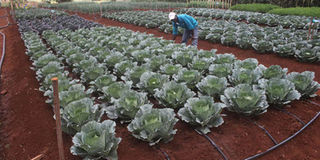Farming mechanisation gets more funding from Treasury

A worker tends to cabbages at Wambugu Agricultural training centre in Nyeri on February 16, 2018. FILE PHOTO | NMG
What you need to know:
- Budget estimates for 2018/2019 indicate that mechanisation will get Sh500 million from Sh100 million in the last financial year.
- Farmers will also benefit from improved allocation to subsidised fertiliser as the funds have been increased by Sh200 million to Sh4.3 billion.
- Maize producers with crop on less than five acres have been offered subsidised insurance should their expected yields fall by more than a fifth.
- Food takes up the largest share (36 per cent) of the basket of commodities used to calculate inflation, making it the main driver of the cost of living.
The Treasury has increased funding for mechanisation, subsidy fertiliser and small scale irrigation to boost food production and ease inflationary pressure.
Budget estimates for 2018/2019 indicate that mechanisation will get Sh500 million from Sh100 million in the last financial year.
Farmers will also benefit from improved allocation to subsidised fertiliser as the funds have been increased by Sh200 million to Sh4.3 billion.
Agriculture is one of President Uhuru Kenyatta’s Big Four agenda and the government is placing focus on the sector to increase food production in a country that has always relied on imports to bridge the deficit.
Mwea Irrigation Scheme, the country’s largest rice project had its budget allocation for the coming financial year cut from Sh2.1 million last year to Sh1.6 million.
In 2017, the price of rice shot by 38 per cent occasioned by production shortfall.
The move saw the value of rice imports increase to Sh15.89 billion in the six months to June last year, up from Sh6.6 billion in the same period the previous period. The volume of imported rice rose to 353,082 tonnes from 261,819 tonnes in the same period in 2016.
Food takes up the largest share (36 per cent) of the basket of commodities used to calculate inflation, making it the main driver of the cost of living.
Declining prices
Data by the Kenya National Bureau of Statistics (KNBS) showed inflation fell to 3.73 per cent last month from 4.18 per cent in March on account of declining food prices.
Crop farmers will also benefit from increased funding on insurance, which has shot from Sh300 million last year to Sh700 million this financial year.
The government rolled out insurance programme in 2015 to cushion farmers against adverse weather conditions.
Maize producers with crop on less than five acres have been offered subsidised insurance should their expected yields fall by more than a fifth.
The government pays 50 per cent of the premium cost to farmers with less than five acres under maize in the scheme offered by APA insurance, Amaco, CIC, Heritage, Jubilee, Kenya Orient and UAP.
The government was banking on the fertiliser blending plant by Toyota Tsusho to ease the shortage of the commodity in the country and cut down on imports.
The Eldoret-based plant, which is a subsidiary of the Japanese conglomerate, was commissioned in 2016.
This is the first phase, which mainly does blending. The firm is expected to put up the second for production of DAP, urea and Calcium Ammonium Nitrogen (CAN) fertilisers.
The government subsidised fertiliser sells at Sh1,500 for a 50 kilogramme bag of DAP compared with the market rate of Sh3,500 for the same quantity.
Kenya received Sh10 billion line of credit from India to aid in mechanisation of agriculture.
The deal was reached last year following the visit by indian Prime Minister Narendra Modi.




